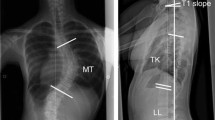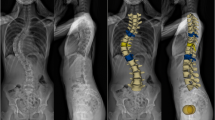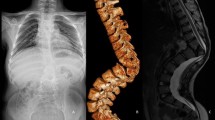Abstract
Purpose
To investigate whether the sagittal morphology differs between the left and right thoracic curves in patients with Chiari malformation-associated scoliosis (CMS).
Methods
Thirty-four patients with a left thoracic curve constituted the CM-L group, whereas 44 patients with a right thoracic curve were assigned into the CM-R group. Another cohort of 90 age- and gender-matched asymptomatic adolescents was enrolled to serve as the control group. Seven sagittal parameters were evaluated on standing lateral radiographs, including thoracic kyphosis (TK), lumbar lordosis (LL), thoracolumbar junctional kyphosis (TJK), sagittal vertical axis (SVA), pelvic incidence (PI), pelvic tilt (PT) and sacral slope (SS).
Results
Compared to the normal controls, the TK, LL and SS were significantly greater in the CM-L group, along with a significantly decreased PT. Similar changes in SS and PT were also demonstrated in the CM-R group, while the TK and LL were found to be relatively normal compared with the control group. Concerning CMS patients with different curve directions, significantly increased TK and LL were observed in the CM-L group, whereas all three pelvic parameters were similar for the two groups. In addition, no significant differences were noted between the three groups in PI, TJK or SVA. Moreover, the LL was strongly related to the TK and SS in all three groups, but to the PI only in the control and CM-R groups. A significant correlation was also noted between TK and SS in the CM-L group.
Conclusions
Significant differences in sagittal profiles indeed exist between CMS patients and healthy adolescents, as well as between CMS patients with different curve directions. In CMI patients with a left thoracic curve, compensatory alterations appear to occur in LL in response to the increased TK to maintain a balanced posture.


Similar content being viewed by others
References
Mac-Thiong JM, Labelle H, Charlebois M, Huot MP, Guise JAd (2003) Sagittal plane analysis of the spine and pelvis in adolescent idiopathic scoliosis according to the coronal curve type. Spine (Phila Pa 1976) 28:1404–1409
Bourghli A, Aunoble S, Reebye O, Huec JC (2011) Correlation of clinical outcome and spinopelvic sagittal alignment after surgical treatment of low-grade isthmic spondylolisthesis. Eur Spine J 20:663–668. doi:10.1007/s00586-011-1934-z
Chaléat-Valayer E, Mac-Thiong JM, Paquet J, Berthonnaud E, Siani F, Roussouly P (2011) Sagittal spino-pelvic alignment in chronic low back pain. Eur Spine J 20:634–640. doi:10.1007/s00586-011-1931-2
Loder RT, Stasikelis P, Farley FA (2002) Sagittal profiles of the spine in scoliosis associated with an Arnold-Chiari malformation with or without syringomyelia. J Pediatr Orthop 22:483–491. doi:10.1097/01.bpo.0000018992.02445.bc
Spiegel DA, Flynn JM, Stasikelis PJ, Dormans JP, Drummond DS, Gabriel KR, Loder RT (2003) Scoliotic curve patterns in patients with Chiari I malformation and/or syringomyelia. Spine (Phila Pa 1976) 28:2139–2146
Qiu Y, Zhu Z, Wang B, Yu Y, Qian B, Zhu F (2008) Radiological presentations in relation to curve severity in scoliosis associated with syringomyelia. J Pediatr Orthop 28:128–133
Richards BS, Sucato DJ, Johnston CE, Diab M, Sarwark JF, Lenke LG, Group SDS (2010) Right thoracic curves in presumed adolescent idiopathic scoliosis: which clinical and radiographic findings correlate with a preoperative abnormal magnetic resonance image? Spine (Phila Pa 1976) 35:1855–1860
Wu L, Qiu Y, Wang B, Zhu ZZ, Ma WW (2010) The left thoracic curve pattern: a strong predictor for neural axis abnormalities in patients with “idiopathic” scoliosis. Spine (Phila Pa 1976) 35:182–185
Yong Q, Zhen L, Zezhang Z, Bangping Q, Feng Z, Tao W, Jun J, Xu S, Xusheng Q, Weiwei M, Weijun W (2012) Comparison of sagittal spinopelvic alignment in Chinese adolescents with and without idiopathic thoracic scoliosis. Spine (Phila Pa 1976) 37:E714–E720. doi:10.1097/BRS.0b013e3182444402
Akbar M, Terran J, Ames CP, Lafage V, Schwab F (2013) Use of Surgimap Spine in sagittal plane analysis, osteotomy planning, and correction calculation. Neurosurg Clin N Am 24:163–172. doi:10.1016/j.nec.2012.12.007
Legaye J, Duval-Beaupère G, Hecquet J, Marty C (1998) Pelvic incidence: a fundamental pelvic parameter for three-dimensional regulation of spinal sagittal curves. Eur Spine J 7:99–103
Upasani VV, Tis J, Bastrom T, Pawelek J, Marks M, Lonner B, Crawford A, Newton PO (2007) Analysis of sagittal alignment in thoracic and thoracolumbar curves in adolescent idiopathic scoliosis: how do these two curve types differ? Spine (Phila Pa 1976) 32:1355–1359
Lafage V, Schwab F, Skalli W, Hawkinson N, Gagey PM, Ondra S, Farcy JP (2008) Standing balance and sagittal plane spinal deformity: analysis of spinopelvic and gravity line parameters. Spine (Phila Pa 1976) 15:1572–1578. doi:10.1097/BRS.0b013e31817886a2
Bernhardt M, Bridwell KH (1989) Segmental analysis of the sagittal plane alignment of the normal thoracic and lumbar spines and thoracolumbar junction. Spine (Phila Pa 1976) 14:717–721
Boseker EH, Moe JH, Winter RB, Koop SE (2000) Determination of “normal” thoracic kyphosis: a roentgenographic study of 121 “normal” children. J Pediatr Orthop 20:796–798
Vedantam R, Lenke LG, Keeney JA, Bridwell KH (1998) Comparison of standing sagittal spinal alignment in asymptomatic adolescents and adults. Spine (Phila Pa 1976) 15:211–215
Nash CL, Moe JH (1969) A study of vertebral rotation. J Bone Joint Surg Am 51:223–229
Mac-Thiong J-M, Labelle H, Berthonnaud E, Betz RR, Roussouly P (2007) Sagittal spinopelvic balance in normal children and adolescents. Eur Spine J 16:227–234. doi:10.1007/s00586-005-0013-8
Petcharaporn M, Pawelek J, Bastrom T, Lonner B, Newton PO (2007) The relationship between thoracic hyperkyphosis and the Scoliosis Research Society outcomes instrument. Spine (Phila Pa 1976) 32:2226–2231
Bradley LJ, Ratahi ED, Crawford HA, Barnes MJ (2007) The outcomes of scoliosis surgery in patients with syringomyelia. Spine (Phila Pa 1976) 32:2327–2333
Ouellet JA, LaPlaza J, Erickson MA, Birch JG, Burke S, Browne R (2003) Sagittal plane deformity in the thoracic spine: a clue to the presence of syringomyelia as a cause of scoliosis. Spine (Phila Pa 1976) 28:2147–2151
Propst-Proctor SL, Bleck EE (1983) Radiographic determination of lordosis and kyphosis in normal and scoliotic children. J Pediatr Orthop 3:344–346
Lonner BS, Auerbach JD, Sponseller P, Rajadhyaksha AD, Newton PO (2010) Variations in pelvic and other sagittal spinal parameters as a function of race in adolescent idiopathic scoliosis. Spine (Phila Pa 1976) 35:E374–E377. doi:310.1097/BRS.1090b1013e3181bb1094f1096
Cil A, Yazici M, Uzumcugil A, Kandemir U, Alanay A, Alanay Y, Acaroglu RE, Surat A (2005) The evolution of sagittal segmental alignment of the spine during childhood. Spine (Phila Pa 1976) 30:93–100
Voutsinas SA, MacEwen GD (1986) Sagittal profiles of the spine. Clin Orthop 210:235–242
Blondel B, Lafage V, Schwab F, Farcy JP, Bollini G, Jouve JL (2012) Reciprocal sagittal alignment changes after posterior fusion in the setting of adolescent idiopathic scoliosis. Eur Spine J 21:1964–1971. doi:10.1007/s00586-012-2399-4
Mac-Thiong J-M, Labelle H, Roussouly P (2011) Pediatric sagittal alignment. Eur Spine J 20:586–590. doi:10.1007/s00586-011-1925-0
Kuklo TR, Potter BK, Lenke LG (2005) Vertebral rotation and thoracic torsion in adolescent idiopathic scoliosis: what is the best radiographic correlate? J Spinal Disord Tech 18:139–147
Acknowledgments
This work was supported by China Postdoctoral Science Foundation funded project (Grant No.20110490131).
Conflict of interest
No benefits in any form have been or will be received from a commercial party related directly or indirectly to the subject of this manuscript.
Author information
Authors and Affiliations
Corresponding author
Additional information
S. Sha and Z. Zhu contributed equally to this work.
Rights and permissions
About this article
Cite this article
Zhu, Z., Sha, S., Liu, Z. et al. Sagittal spinopelvic alignment in adolescent thoracic scoliosis secondary to Chiari I malformation: a comparison between the left and the right curves. Eur Spine J 23, 226–233 (2014). https://doi.org/10.1007/s00586-013-2980-5
Received:
Revised:
Accepted:
Published:
Issue Date:
DOI: https://doi.org/10.1007/s00586-013-2980-5




